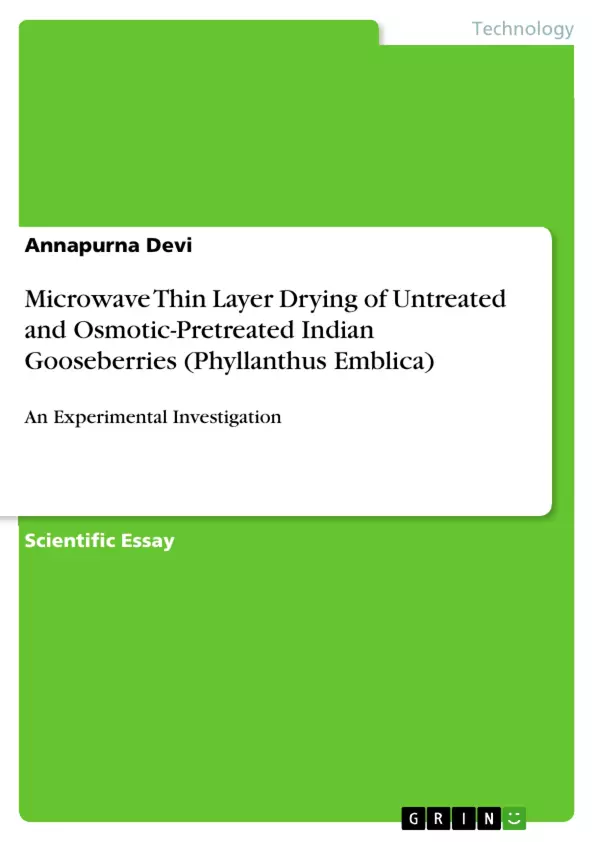The thin layer drying characteristics of untreated and osmotic-pretreated Indian gooseberries were examined using a laboratory microwave dryer at five different powers. Hypertonic solutions like 10%NaCl and 20%NaCl were used for osmotic-pretreatment of Indian gooseberries. Drying was carried out until constant values were obtained. The drying curves obtained from the experimental data were fitted to different thin layer drying models. All the models were compared according to three statistical parameters χ2, RMSE and R2.
The results showed that gooseberries pretreated in 20%NaCl solution took lesser drying time than gooseberries pretreated in 10%NaCl solution and untreated samples. Midilli model was found to be the best model for describing the drying curve of Indian gooseberries. Effective diffusivities and drying coefficient (k) for untreated and pretreated Indian gooseberries were calculated at five microwave powers using linear regression method. Biot number for untreated and pretreated Indian gooseberries was calculated using standard mass transfer equations.
Table of Contents
- Introduction:
- Materials and methods:
- Materials:
- Experimental setup:
- Experimental procedure:
- Analysis of drying data:
- Results and discussion
- Estimation of parameters and comparison of drying curve models.
- Determination of effective diffusivities
- Drying rate curves:
- FMC versus RATE:
- Development of model:
- Determination of drying coefficient and Biot number.
- Conclusion......
- References:
Objectives and Key Themes
This research aims to examine the thin layer drying characteristics of untreated and osmotic-pretreated Indian gooseberries using a microwave dryer. The study investigates the drying rates of gooseberries subjected to different pre-treatment solutions and fits experimental data to various drying models to calculate effective diffusivities. It also aims to develop a drying model for both untreated and pretreated gooseberries and calculate the drying coefficient and Biot number using basic mass transfer equations.
- Microwave drying of Indian gooseberries
- Osmotic pre-treatment effects on drying rates
- Mathematical modeling of drying curves
- Effective diffusivities and drying coefficients
- Biot number determination
Chapter Summaries
The introduction discusses the benefits of microwave drying in food processing, highlighting its efficiency compared to conventional hot air drying. It also explains the role of osmotic dehydration in fruit and vegetable pretreatment, focusing on its application in extending the shelf life of Indian gooseberries.
The "Materials and methods" chapter details the experimental setup and procedures, including the preparation of Indian gooseberries, the use of microwave dryer and different pre-treatment solutions, and the collection and analysis of drying data. The section also explains the mathematical models used to fit the drying curves and the statistical parameters employed for model evaluation.
The "Results and discussion" chapter presents the results of the experiments, focusing on the comparison of different drying models and the determination of effective diffusivities, drying coefficients, and Biot numbers for untreated and pretreated Indian gooseberries.
Keywords
This research focuses on microwave drying, Indian gooseberries, drying models, statistical parameters, effective diffusivity, and Biot number. The study investigates the impact of osmotic pre-treatment on drying rates and explores the applicability of various models to describe the drying process.
- Quote paper
- Annapurna Devi (Author), 2016, Microwave Thin Layer Drying of Untreated and Osmotic-Pretreated Indian Gooseberries (Phyllanthus Emblica), Munich, GRIN Verlag, https://www.hausarbeiten.de/document/352790


